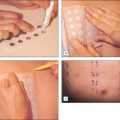Chapter 1 Cosmeceuticals and the Practice of Dermatology
THE COSMETICS MARKETPLACE
• Growing demand
In 2003, the total US cosmetics market was valued at $45.5 billion, with skin care products accounting for $15 billion alone. Table 1.1 depicts a further breakdown of spending by category. Within skin care products, antiaging and sun protection products are at the top of the demand and drive the overall industry. Cosmeceuticals are growing faster than any other sector. The US cosmeceutical market reached $5.4 billion in 2005 with skin care products accounting for up to 60–80% of cosmeceutical sales according to the Fredonia Group, an industry market research firm. US demand for cosmeceutical products is projected to grow by 11% per year to $7 billion in 2010, with demand for antiaging agents expanding at twice the rate of other skin care cosmeceuticals.
| Category | $ billions |
| Color cosmetics | $15.2 |
| Skin care | $15 |
| Body and bath products | $6.4 |
| Women’s fragrances | $6.2 |
| Men’s products | $2.6 |
Source: CosmeticIndustry.com
• Regulatory issues and product development
From a regulatory perspective, cosmeceuticals don’t really exist. It is a functional but not legal term used primarily for marketing purposes by cosmetic manufacturers, who cannot claim drug-like ingredients or benefits for their products. Cosmeceuticals are legally classified as cos-metics by the Food, Drug, and Cosmetic Act as topical products intended ‘for cleansing, beautifying, promoting attractiveness, or altering the appearance’. Yet, cosmeceutical products contain an endless list of supposedly active substances (a partial listing of agents by category is provided in Table 1.2). Most of these ingredients do not meet Kligman’s definition of efficacy—namely, proof of penetration, identifiable mechanism of action, and evidence of clinical value. In addition to scientifically demonstrable efficacy, characteristics of the ideal cosmeceutical product would include immediate and long-lasting results, low side effect profile, preventive benefits, and application to a variety of skin concerns including texture, pigmentation, and laxity.
| Category | Agent |
| Vitamins |
Regulatory restriction prevents cosmetic manufacturers from developing products containing truly active ingredients. Efficacy claims must be carefully worded so as not to attract the attention of regulators. Expensive and lengthy clinical trials are unfeasible for a highly competitive industry that must respond quickly to changing fashion. As such, pharmaceutical companies traditionally have not been major players in the cosmeceutical arena. More recently, however, the promise and potential of high-ticket products have lured major players such as Allergan to the table, and pharmaceutical involvement is likely to increase as the market continues to expand.
BEST PRACTICES FOR DERMATOLOGISTS
• Patient education and compliance
Although cosmetics have had a great safety record overall, we must diligently keep abreast of reported reactions from new agents, including those with natural and botanical ingredients. In addition to the medical literature, the Cosmetic, Toiletry and Fragrance Association’s Cosmetic Ingredient Review expert panel listing of unsafe ingredients is a good source of information (http://www.cir-safety.org). The greatest risk to patients may be in wasting their money—not a life-threatening situation, but something to try to avoid nonetheless. Discouraged patients can be lost to follow-up, making it all the more difficult to judge overall outcomes.
• Dispensing products
There is a great deal of debate about the appropriateness of selling products in the office. Dermatologists have always compounded medicinal products, and this is considered to be a valuable and accepted aspect of our practice. Dispensing cosmetic products, despite potential conflicts of interest, can provide patients with a value-added service and help us remain competitive. If you choose to sell products in your office, be aware of ethical boundaries. Promote only those products you believe in and let patients know exactly what to expect. Don’t claim to be the developer of products that you purchase from a private label manufacturer. Remain familiar with other products on the market and continue to provide objective advice about them. It’s a good idea to be familiar with the American Academy of Dermatology’s dispensing guidelines for prescription and nonprescription products (summarized in Box 1.1). In addition to these prudent standards, whenever possible, it is best to have an intermediary such as a nurse or aesthetician involved.
 DO NOT place your own financial interests above the well-being of patients
DO NOT place your own financial interests above the well-being of patients
 DO NOT price products at an excessive mark-up
DO NOT price products at an excessive mark-up
 DO NOT create an atmosphere of coercive selling
DO NOT create an atmosphere of coercive selling
 DO NOT sell products whose claims of benefit lack validity
DO NOT sell products whose claims of benefit lack validity
 DO NOT represent products as ‘special formulations’ not available elsewhere if this is not the case
DO NOT represent products as ‘special formulations’ not available elsewhere if this is not the case
 DO clearly list all ingredients, including generic names of drugs
DO clearly list all ingredients, including generic names of drugs
 DO advise patients of alternative purchase options if products are available elsewhere
DO advise patients of alternative purchase options if products are available elsewhere
 DO provide prescription refills that can be filled outside the office if patients so choose
DO provide prescription refills that can be filled outside the office if patients so choose
Source: Ethical Limits of Drug Dispensing in the Dermatologist’s Office: American Academy of Dermatology Advisory Board Resolution 1997. From the American Academy of Dermatology
SUMMARY
We live in an extremely competitive and fast-paced society that places a premium on a youthful and healthy appearance. Consequently, many people feel a sense of anxiety about the visible signs of aging and seek our advice about what to do. As dermatologists, we understand that the preservation of healthy and attractive skin is of great value to the happiness and well-being of our patients. Therefore, we have a unique and important role in the growing use of biologically active cosmetics and must address this phenomenon collectively as a profession and in our daily interactions with patients. We should strive for a more proactive involvement with clinical trials as the push to develop new products accelerates. We must help shape the dissemination of information as new products emerge. Most importantly, our profession must continue to take an active role with our patients and the public at large to dispel myths and misconceptions and warn of any potential risks.
American Academy of Dermatology. Position Statement on Dispensing. September 26, 1999. Schaumberg, IL: American Academy of Dermatology, 1999.
Choi CM, Berson DS. Cosmeceuticals. Seminars in Cutaneous Medicine and Surgery. 2006;25:163–168.
Farris PK. Office dispensing: a responsible approach. Seminars in Cutaneous Medicine and Surgery. 2000;19:100–195.
Fredonia Group. Cosmeceuticals: US industry study with forecasts to 2010 & 2015. Available http://www.fredoniagroup.com.
Kligman D. Cosmeceuticals. Dermatologic Clinics. 2000;18:609–615.
Kligman A. A dermatologist looks to the future: promises and problems. Dermatologic Clinics. 2000;18:699–709.
Lamberg L. ‘Treatment’ cosmetics: hype or help? Journal of the American Medical Association. 1998;279:1595–1596.
Lamberg L. Sunscreen, in-office dispensing, surgery debated at annual dermatology meeting. Journal of the American Medical Association. 1999;281:1363–1364.
Millikan LE. Cosmetology, cosmetics, cosmeceuticals: definitions and regulations. Clinics in Dermatology. 2001;19:371–374.
Moore A. The biochemistry of beauty. The science and pseudo-science of beautiful skin. EMBO Reports. 2002;3:714–717.
Ogbogu P, Fleischer AB, Brodell RT, et al. Physicians’ and patients’ perspectives on office-based dispensing: the central role of the physician–patient relationship. Archives of Dermatology. 2001;137:151–154.
Pearson H. Drug discovery: in the eye of the beholder. Nature. 2003;424:990.
Sadick N. Cosmeceuticals: their role in dermatology practice. Journal of Drugs in Dermatology. 2003;2:529–537.





